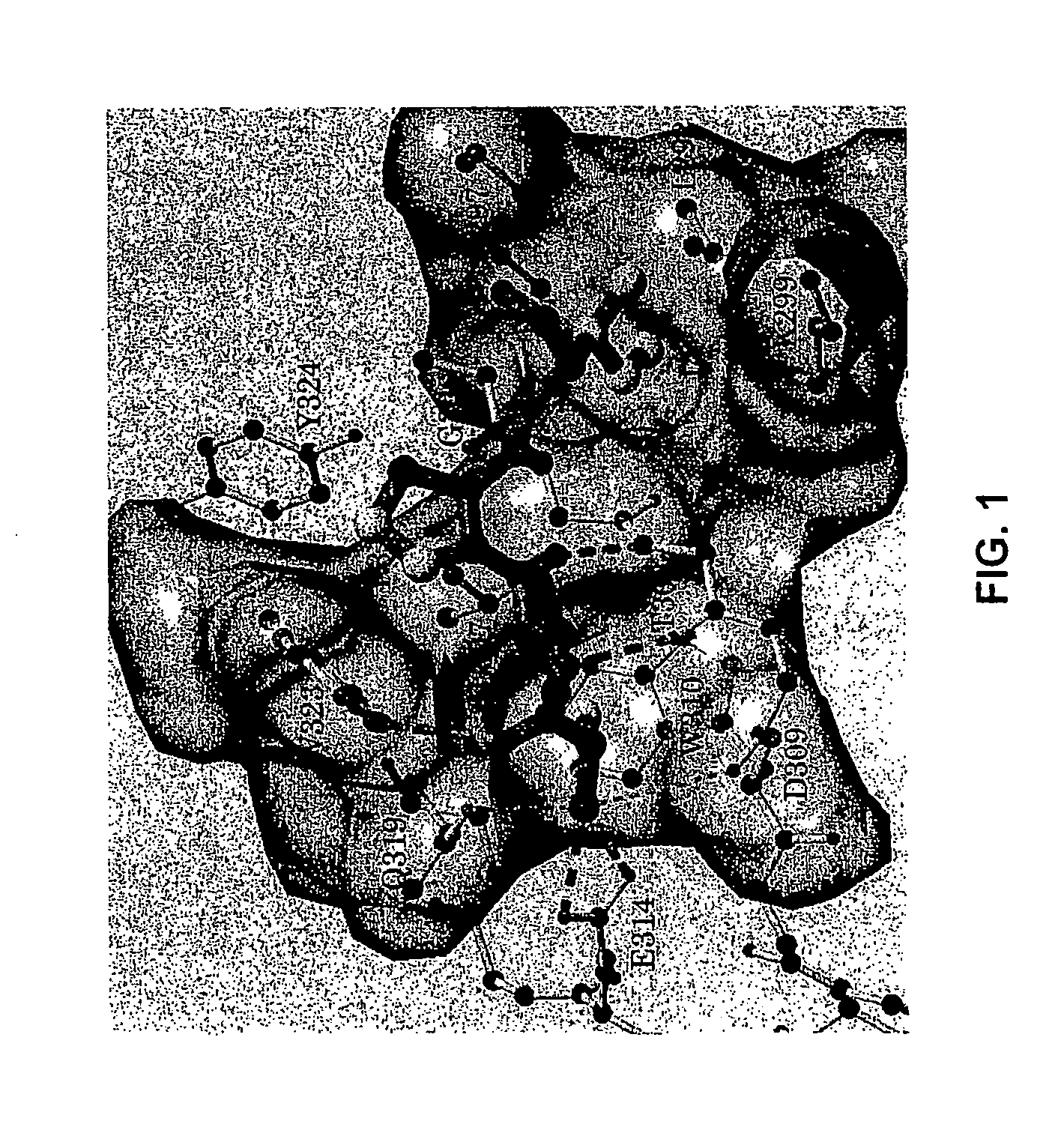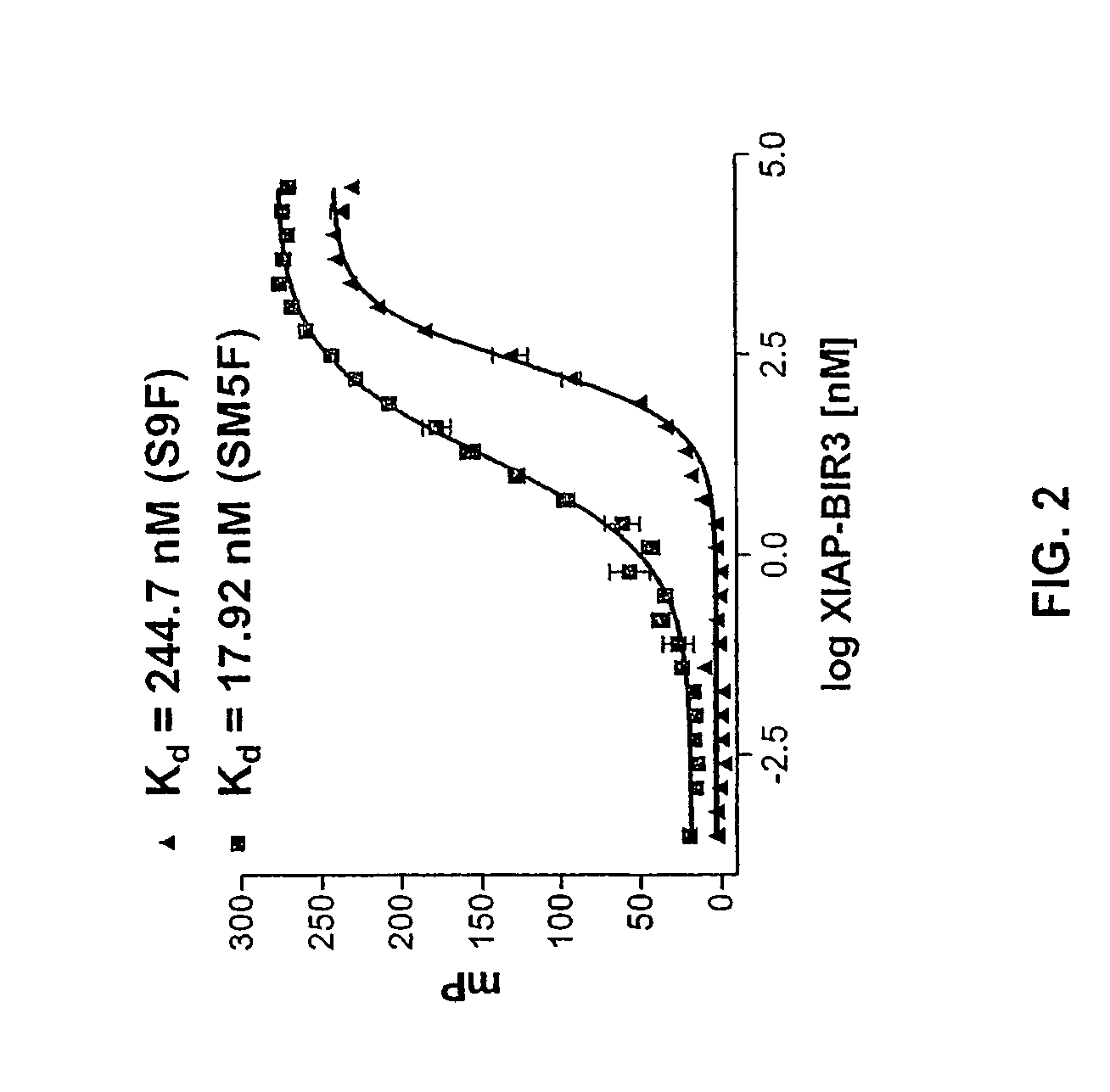Conformationally Constrained Smac Mimetics and the Uses Thereof
a smac mimetics and conformationally constrained technology, applied in the field of medical chemistry, can solve the problems of poor cell permeability, poor in vivo stability, intrinsic limitations of peptide-based inhibitors as potentially useful therapeutic agents, etc., and achieve the effect of increasing expression
- Summary
- Abstract
- Description
- Claims
- Application Information
AI Technical Summary
Benefits of technology
Problems solved by technology
Method used
Image
Examples
example 1
Development of Fluorescence Polarization Assay
[0131]A quantitative in vitro binding assay using fluorescence polarization was developed. Binding of Smac to MAP is mediated by a few amino acid residues at the N-terminus of Smac (FIG. 1). Two different fluorescent probes were synthesized: the natural 9-mer Smac peptide (AVPIAQKSEK (SEQ ID NO:3)) and a mutated 5-mer Smac peptide (AbuRPFK, wherein Abu=2-aminobutyric acid (SEQ ID NO:4)). Each probe was labeled with 6-carboxyfluorescein succinimidyl ester (FAM) as the fluorescent tag (AVPIAQKSEK-FAM, termed S9F and AbuRPFK-FAM, termed SM5F, respectively). The unlabeled 9-mer and 5-mer Smac peptides (S9 and SM5) were used as the positive controls. The human XIAP-BIR3 protein (residues 241-356) with a His tag is stable and soluble and was used for the binding assay.
[0132]The dissociation constant value of the fluorescent labeled S9F and SM5F to XIAP-BIR3 was first determined using a constant concentration of the peptide (5 nM) and titrating...
example 2
Analysis of the Interaction Between Smac and XIZP BIR3 Based Upon Experimental 3D Structures
[0136]The high resolution experimental 3D structures of the XIAP BIR3 domain in complex with Smac protein and peptide (FIG. 1) provided a solid structural basis for the design of potent Smac mimetics. The amine group of alanine in position 1 (A1′) forms four hydrogen bonds with the side chain of Q319 and E314 and the backbone carbonyl group of D309. The methyl group in alanine binds to a small but well-defined hydrophobic pocket. Our analysis showed that this hydrophobic pocket may accommodate a slightly larger hydrophobic group than methyl. The backbone carbonyl of the alanine residue forms a hydrogen bond with the side chain of W323 but this hydrogen bond is not optimal based upon its geometric parameters.
[0137]The amino and carbonyl groups of valine (V2′) in Smac form two optimal hydrogen bonds to the backbone carbonyl and amino groups of T308, respectively. Its side chain isopropyl group ...
example 3
Design of Conformationally Constrained Non-Peptidic Smac Mimetics
[0141]The design and modification of the Smac AVPI peptide led to potent simple Smac peptido-mimetics. However, these Smac mimetics have 2-3 natural amino acids and 1-2 natural peptide bonds. To further reduce the peptide characteristics in these simple Smac mimetics, conformationally constrained non-peptidic Smac mimetics were designed and synthesized based upon the 3D complex structures and data obtained from the simple Smac peptido-mimetics.
[0142]The experimental 3D structures of Smac in complex with XIAP BIR3 and our modeled structure for Smac AVPI (SEQ ID NO:1) in which the isoleucine has been replaced with benzylamine (compound 1) (FIGS. 1 and 4) showed that the side chain of valine and proline ring in the Smac AVPI peptide (SEQ ID NO:1) and compound 1 point toward solvent of the binding groove. Therefore it is possible to cyclize these two residues through formation of an additional ring system without causing s...
PUM
| Property | Measurement | Unit |
|---|---|---|
| Molar density | aaaaa | aaaaa |
| Molar density | aaaaa | aaaaa |
| Molar density | aaaaa | aaaaa |
Abstract
Description
Claims
Application Information
 Login to View More
Login to View More - R&D
- Intellectual Property
- Life Sciences
- Materials
- Tech Scout
- Unparalleled Data Quality
- Higher Quality Content
- 60% Fewer Hallucinations
Browse by: Latest US Patents, China's latest patents, Technical Efficacy Thesaurus, Application Domain, Technology Topic, Popular Technical Reports.
© 2025 PatSnap. All rights reserved.Legal|Privacy policy|Modern Slavery Act Transparency Statement|Sitemap|About US| Contact US: help@patsnap.com



